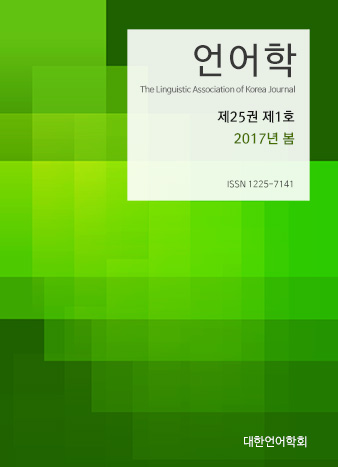대한언어학회 전자저널

-
Why is the Locative NP in Kiswahili not Syntactically Oblique?
-
Developmental Errors in Chinese L1 Speakers’ Use of the L2 English Past Tense and Perfective Aspect
-
An Exploration of High School Reading Test Items Based on Discriminant Analysis
-
Marketization of University Brochures in Korea and the US: From a Genre Analysis Perspective
25권 1호 (2017년 3월)
- Marketization of University Brochures in Korea and the US: From a Genre Analysis Perspective
-
Jeong Eun Kim & Chul Joo Uhm
Pages : 93-115
Abstract
Keywords
# Marketization of higher education # genre # brochures
References
- Askehave, I. (2007). The impact of marketization on higher education genres—the international student prospectus as a case in point. Discourse Studies, 9(6), 723-742.
- Askehave, I., & Swales, J. M. (2001). Genre identification and communicative purpose: A problem and a possible solution. Applied Linguistics, 22(2), 195-212.
- Balmer, J. M., & Greyser, S. A. (2006). Corporate marketing: Integrating corporate identity, corporate branding, corporate communications, corporate image and corporate reputation. European Journal of Marketing, 40(7/8), 730-741.
- Bano, Z., & Shakir, A. (2015). Personal pronouns in “About Us” section of online university prospectus. Journal of Education and Practice, 6(1), 133-139.
- Bhatia, V. (2002). Applied genre analysis: A multi-perspective model. Ibérica: Revista de la Asociación Europea de Lenguas para Fines Específicos (AELFE) (4), 3-19.
- Connell, I., & Galasiński, D. (1998). Academic mission statements: An exercise in negotiation. Discourse & Society, 9(4), 457-479.
- Fairclough, N. (1993). Critical discourse analysis and the marketization of public discourse: The universities. Discourse & Society, 4(2), 133-168.
- Fairclough, N. (2013a). Critical discourse analysis: The critical study of language. London and New York: Routledge.
- Fairclough, N. (2013b). Language and power (2nd ed.). London and New York: Routledge.
- Falsey, T. A. (1989). Corporate philosophies and mission statements: A survey and guide for corporate communicators and management. New York: Quorum Books.
- Han, Z. (2014). The marketization of public discourse: The Chinese universities. Discourse & Communication, 8(1), 85-103.
- Hartley, M., & Morphew, C. C. (2008). What's being sold and to what end?: A content analysis of college viewbooks. The Journal of Higher Education, 79(6), 671-691.
- Hui, K. L. (2009). Higher education in a globalised market: A comparative discourse study of university prospectuses in Hong Kong and the United Kingdom. Unpublished master's thesis, The University of Edinburgh, Edinburgh, Lothian, UK.
- Hyland, K. (2001). Bringing in the reader addressee features in academic articles. Written Communication, 18(4), 549-574.
- Kheovichai, B. (2014). Marketization in the language of UK university recruitment: A critical discourse analysis and corpus comparison of university and finance industry job advertisements. Unpublished doctoral dissertation, University of Birmingham, Birmingham, West Midlands, UK.
- Kwong, J. (2000). Introduction: Marketization and privatization in education. International Journal of Educational Development, 20(2), 87-92.
- Mangold, W. G., & Faulds, D. J. (2009). Social media: The new hybrid element of the promotion mix. Business Horizons, 52(4), 357-365.
- Newsom, D., & Haynes, J (8th ed.). (2007). Public relations writing: Form & style. Belmont: Cengage Learning.
- Osman, H. (2008). Re-branding academic institutions with corporate advertising: A genre perspective. Discourse & Communication, 2(1), 57-77.
- Rytel, T. (2010). Emotional marketing concept: The new marketing shift in the postmodern era. Verslas: teorija ir praktika, 11(1), 30-38.
- Swales, J. (1990). Genre analysis: English in academic and research settings. Cambridge: Cambridge University Press.
- Swales, J. (2004). Research genres: Explorations and applications. Cambridge: Cambridge University Press.
- Teo, P. (2007). The marketisation of higher education: A comparative case-study of two universities in Singapore. Critical Approaches to Discourse Analysis across Disciplines, 1(1), 95-111. Thompson, C. J., Rindfleisch, A., & Arsel, Z. (2006). Emotional branding and the strategic value of the doppelgänger brand image. Journal of Marketing, 70(1), 50-64. Yang, W. (2013). 'Why choose us?’ texts in university websites: A genre analysis. Taiwan International ESP Journal, 5(1), 45-80.